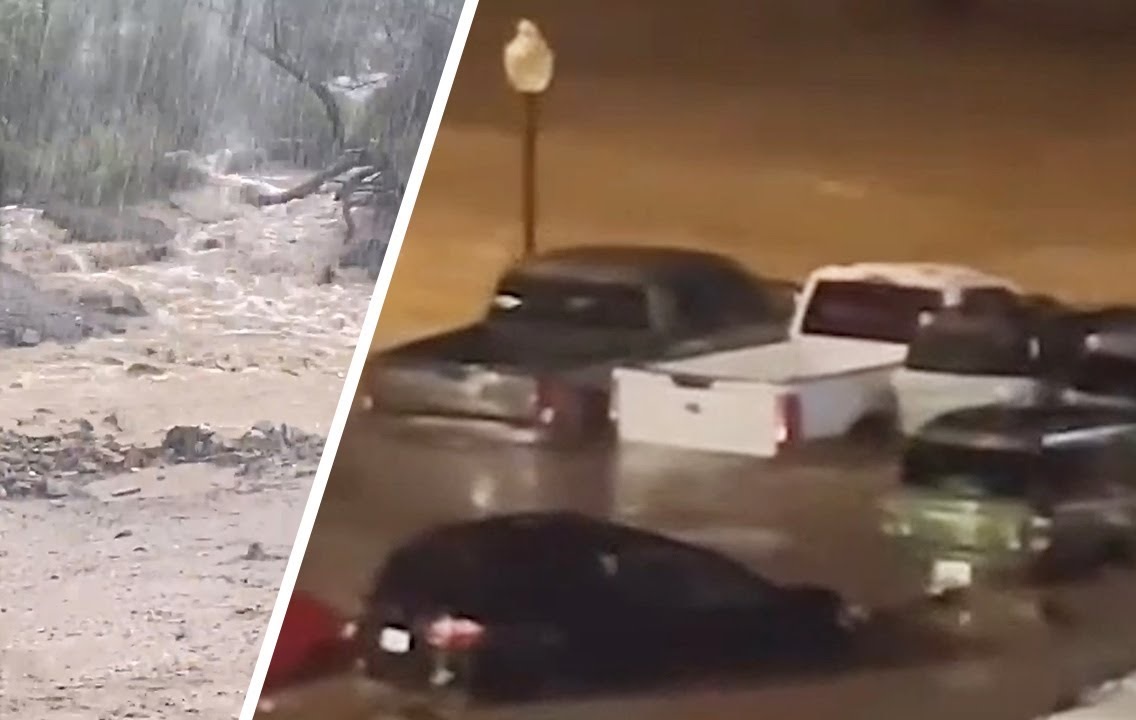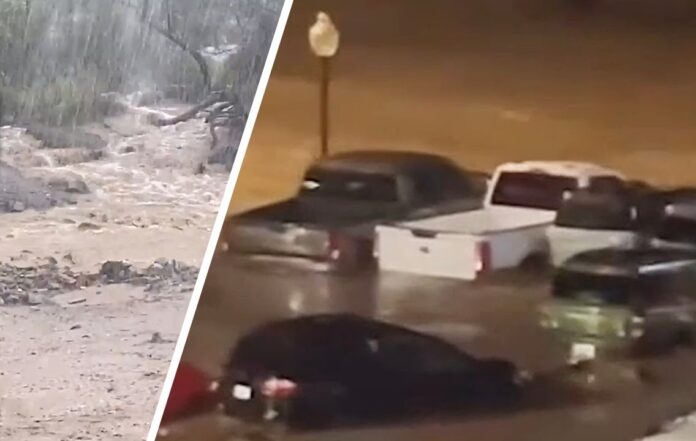One minute you’re grilling in the desert sun—next, a wall of water swallows your town whole, claiming 4 lives and unleashing 1,000 exploding propane tanks. How did Arizona’s monsoon turn paradise into apocalypse overnight?
Survivors climbed rooftops as cars vanished in the torrent. One victim was a beloved local journalist—her final story, untold. What warnings were ignored? Read the full harrowing account…

Torrential monsoon rains that dumped several inches of water in mere hours transformed the arid streets of central Arizona into raging rivers of mud and debris, claiming at least four lives, scattering nearly 1,000 propane tanks like deadly confetti, and leaving a historic mining town in ruins. The flash flooding, which struck late Friday and raged through Saturday, prompted emergency declarations from local and state officials, as rescue crews battled not just the waters but a potential hazmat catastrophe that could ignite at any spark.
The hardest hit was Globe, a dusty gem of the 19th-century mining boom with a population of just 7,000, nestled in the rugged Pinal Mountains about 100 miles east of Phoenix. What began as a typical late-September downpour escalated into a biblical deluge, with the National Weather Service recording up to 5 inches of rain in Gila County between 8 p.m. Friday and 4 a.m. Saturday. Floodwaters surged through downtown, sweeping away vehicles, shattering windows, and turning Broad Street—a hub of antique shops and mom-and-pop diners—into a sludge-choked war zone. By dawn, the scene resembled a post-apocalyptic film set: overturned cars half-buried in muck, power lines dangling like limp noodles, and the acrid scent of propane lingering in the air.
At least three of the fatalities occurred in Globe, where emergency manager Carl Melford confirmed the grim toll during a tense Saturday press briefing outside the Gila County Courthouse. “This was catastrophic—something we’ve never seen in our lifetimes,” Melford said, his voice hoarse from coordinating with out-of-state teams. The victims included two found trapped in a submerged vehicle near the swollen Pinal Creek and a third pulled from the floodwaters downstream, their identities withheld pending family notifications. A fourth death was reported in suburban Scottsdale, where a body was recovered from the Indian Bend Wash after a driver attempted to cross a flooded wash—a perennial killer in the desert Southwest. Officials fear the number could climb; at least two people remain unaccounted for, with search teams combing debris fields as far as Miami, a neighboring copper town equally pummeled.
Eyewitness accounts paint a picture of sheer terror. Adrianne Villalobos, owner of La Casita Mexican Restaurant on Broad Street, was vacationing in California when her staff called in a panic around 10 p.m. Friday. Nine employees and customers had barricaded the doors against the rising waters, only for a drifting SUV to smash through the rear window, unleashing a vortex that filled the dining room “like a giant toilet flushing,” she recounted to The Arizona Republic. They escaped through the breach, wading chest-deep to rooftops where they shivered until dawn. “I built this place with my own hands—now it’s gutted,” Villalobos said, choking back tears as volunteers shoveled silt from her kitchen Monday.
Further compounding the horror was the breach at a local propane distributorship. Around 1,000 tanks—each holding up to 100 gallons of highly flammable gas—were ripped from their moorings and carried miles downstream, littering streets and creeks like forgotten grenades. Gila County Public Health issued shelter-in-place orders Saturday, warning of explosion risks and chemical leaks. Hazmat teams from Phoenix and even California donned protective gear to corral the cylinders, using drones to scan for leaks amid the muck. “One wrong spark, and we’d have had a fireball worse than a wildfire,” said Fire Chief Robert Cooper of the Globe Fire Department, who oversaw the operation. By Sunday, crews had recovered 600 tanks, but the rest bobbed perilously in receding waters, a ticking time bomb in an already devastated community.
Globe Mayor Al Gameros, surveying the wreckage from a commandeered National Guard Humvee, declared a local emergency just after midnight Saturday—the first in the city’s 140-year history. “We’ve weathered mine collapses and economic busts, but this? This is Mother Nature saying, ‘Enough,'” Gameros told reporters, his mud-caked boots a testament to the all-night patrols. Downtown’s Gila County Courthouse, a territorial-era landmark, sustained cracked foundations and flooded basements, while the historic Fox Theater—once a vaudeville hotspot—saw its marquee collapse into the street. Residents like retiree Maria Gonzalez described huddling with neighbors on apartment roofs, using cellphones to light the way as sirens wailed below. “The water came so fast, like a freight train. We lost everything but our lives,” she said, clutching a sodden photo album salvaged from the ruins.
The flooding’s ferocity wasn’t entirely unforeseen, but its scale caught even seasoned meteorologists off guard. Arizona’s monsoon season, which typically peaks in July and August, had been unusually dormant until a stubborn low-pressure system off Southern California’s coast funneled Gulf of Mexico moisture into the state late last week. The result: a “training” effect where storms stalled and repeatedly hammered the same watersheds, saturating burn scars from last year’s wildfires and turning dry arroyos into death traps. The National Weather Service’s Phoenix office issued flash flood warnings at 9:15 p.m. Friday, but in remote Gila County—where cell service flickers and roads snake through canyons—evacuation orders reached some too late.
This isn’t Globe’s first brush with nature’s wrath. In 2021, post-wildfire rains triggered similar slides, burying homes in ash-laden sludge. But locals say Friday’s event dwarfed it. “That was a puddle compared to this ocean,” quipped Carl Melford, who lost a cousin in the earlier flood. Climate experts, speaking to CNN, pointed to broader patterns: warmer oceans evaporating more moisture, intensified by human-driven warming, leading to “rain bombs” in the Southwest. “We’re seeing extremes on steroids—droughts deeper, floods fiercer,” said Dr. Julie Cole, a climatologist at the University of Arizona. Yet, in politically divided Arizona, the disaster sparked finger-pointing: conservatives on X decried “Biden’s green agenda” for weakening infrastructure, while progressives blamed chronic underfunding of rural flood controls.
Among the losses was a poignant one: Heather Poarch Johnson, 52, a veteran reporter for the Arizona Silver Belt, the town’s thrice-weekly paper. Johnson, known for her dogged coverage of mining layoffs and community fundraisers, perished when her car was swept into Pinal Creek while heading home from an evening shift. “She was our voice—the one who made sure Globe wasn’t forgotten,” eulogized publisher Tim O’Rourke in a tear-streaked obituary posted online Sunday. Her death, confirmed by the coroner Monday, drew an outpouring: over 5,000 condolences flooded the paper’s site, with donations pouring in for her two teenage sons.
Statewide, the deluge spared no one. In Scottsdale, a golfer was pulled lifeless from the wash, his clubs bobbing nearby like cruel flotsam. Metro Phoenix, unaccustomed to such volume, saw 1.64 inches citywide—the most since 2018—stranding motorists on the Superstition Freeway and flooding luxury condos in Arcadia. U.S. Highway 60, the vital east-west artery, remained shuttered near milepost 249, with Arizona Department of Transportation crews battling washouts that erased entire shoulders. Power outages affected 12,000 homes, and Salt River Project dams creaked under the strain, forcing controlled releases that kept reservoirs from overflowing but kept kayakers off the water.
Governor Katie Hobbs, a Democrat facing reelection whispers, responded swiftly Saturday morning with a statewide emergency declaration for Gila County—the first since 2023’s Hermits Peak fire. “My heart breaks for these Arizonans,” Hobbs said in a Phoenix briefing, flanked by FEMA liaisons and National Guard brass. The order unlocked $10 million in state aid for search-and-rescue, deploying 150 personnel from Maricopa and Pima counties, plus drones from the Arizona Department of Public Safety. The Guard airlifted supplies to cut-off ranches, while Red Cross shelters at Lee Kornegay Middle School in Miami housed 200 evacuees, serving hot meals amid the chaos. Hobbs coordinated with Sens. Mark Kelly and Kyrsten Sinema, both Democrats, for federal matching funds, though Republican critics like Rep. Eli Crane griped on X about “bureaucratic red tape” slowing reimbursements.
Critics, however, weren’t appeased. X erupted with accusations that Hobbs’ administration—still smarting from 2024’s border crisis—prioritized migrant aid over rural preparedness. “Where was the governor when Globe needed her? Hiding behind press releases,” tweeted one user, echoing a thread with 2,000 likes slamming the lack of early evac drills. Hobbs countered in a Sunday address, vowing audits of the state’s flood warning system and $50 million in infrastructure bonds for monsoon-proofing washes. “This isn’t partisan—it’s survival,” she insisted, drawing bipartisan nods from mayors in flood-prone Flagstaff.
As cleanup crews—bolstered by volunteers from as far as Nevada—pushed through Monday, the human toll emerged. Businesses tallied millions in losses: the Copper Country News, co-owned with Johnson’s paper, lost its printing press to a foot of silt. Families sifted through wreckage for heirlooms, while counselors fanned out to schools where kids drew crayon pictures of “angry rain monsters.” Economic ripple effects loomed: Globe’s tourism, buoyed by its Route 66 vibe and mining museum, could crater without quick federal loans.
Yet amid the devastation, glimmers of resilience shone. Neighbors formed bucket brigades to clear storm drains, and local breweries canned “Globe Strong” ales for fundraisers. Faith leaders packed Miami’s Our Lady of the Angels Church for a Sunday vigil, where survivors lit candles for the lost. “We’ve been knocked down before—miners’ strikes, recessions—but we rise,” preached Father Miguel Ruiz, his homily broadcast live on X to 10,000 viewers.
Meteorologists forecast drier days ahead, but the scars run deep. In a state where water is life—and death—the floods serve as a stark reminder: in the desert, abundance can turn assassin in an instant. As Globe rebuilds, one question hangs heavy: How many more deluges before the warnings become walls?
For now, the community clings to normalcy. Monday markets reopened with half-stalls, vendors hawking tamales amid the mud. And in the distance, the Pinal Mountains loom, silent sentinels over a town forever altered—washed clean, but not unbroken.
